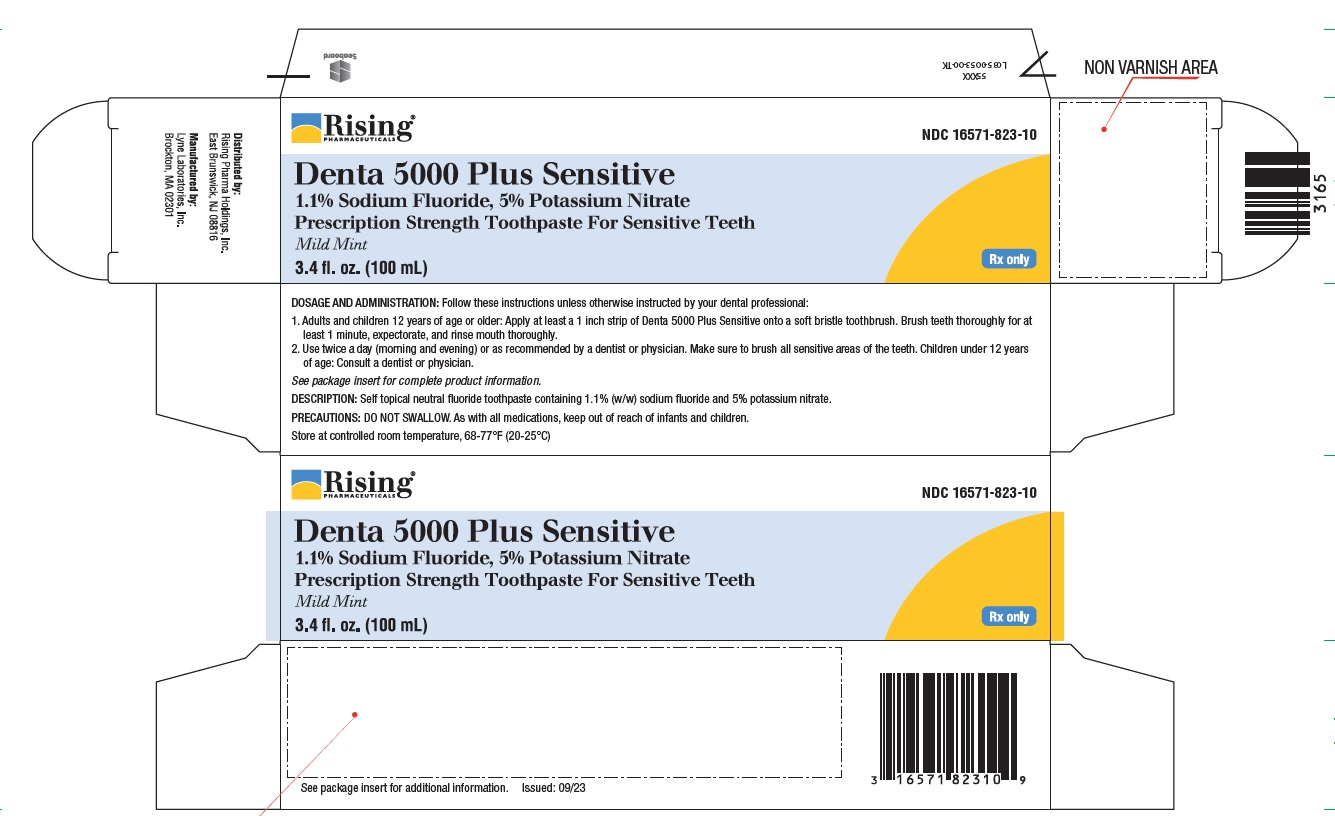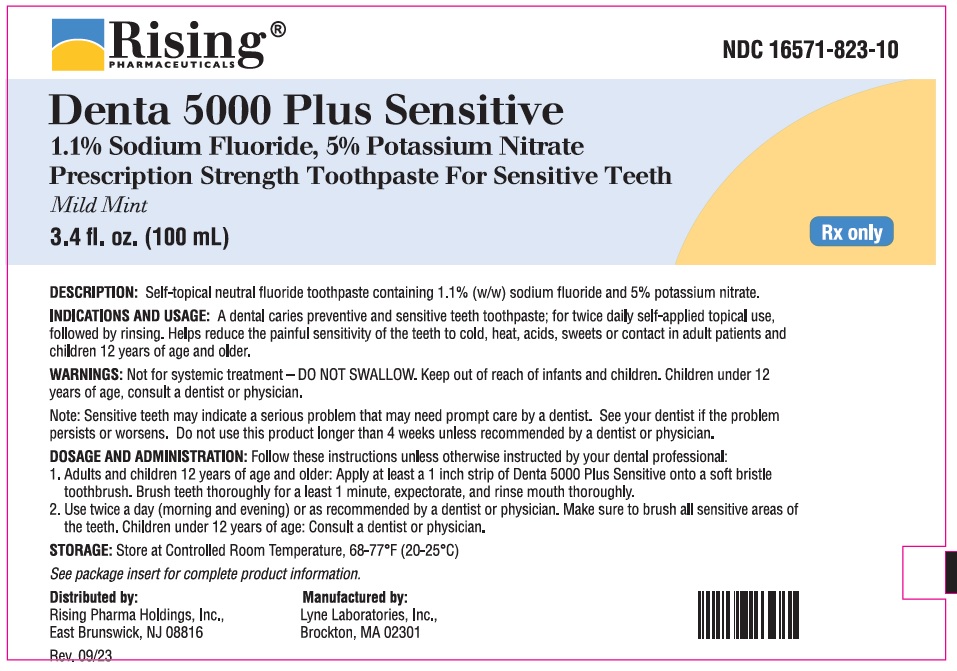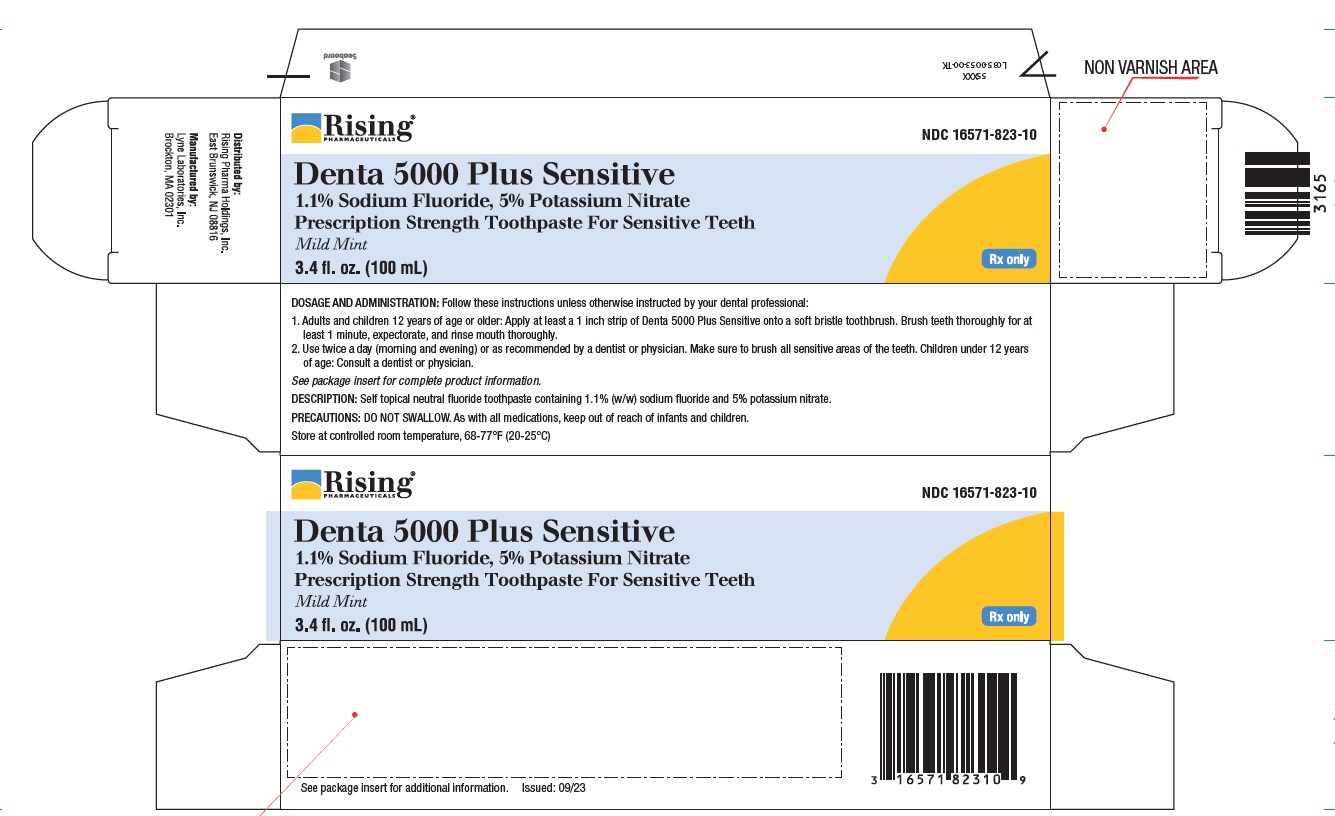Label: DENTA 5000 PLUS SENSITIVE- sodium fluoride and potassium nitrate gel, dentifrice
- NDC Code(s): 16571-823-10
- Packager: Rising Pharma Holdings, Inc.
- Category: HUMAN PRESCRIPTION DRUG LABEL
- DEA Schedule: None
- Marketing Status: unapproved drug other
DISCLAIMER: This drug has not been found by FDA to be safe and effective, and this labeling has not been approved by FDA. For further information about unapproved drugs, click here.
Drug Label Information
Updated November 9, 2023
If you are a consumer or patient please visit this version.
- Download DRUG LABEL INFO: PDF XML
- Official Label (Printer Friendly)
- SPL UNCLASSIFIED SECTION
- Description:
- Active Ingredients:
- Inactive Ingredients:
- CLINICAL PHARMACOLOGY:
-
INDICATIONS AND USAGE:
A dental caries preventive and sensitive teeth toothpaste; for twice daily self-applied topical use, followed by rinsing. Helps reduce the painful sensitivity of the teeth to cold, heat, acids, sweets or contact in adult patients and children 12 years of age and older. It is well established that 1.1% sodium fluoride is safe and extraordinarily effective as a caries preventive when applied frequently with mouthpiece applicators.1-4 Denta 5000 Plus Sensitive 1.1% sodium fluoride toothpaste with 5% potassium nitrate in a squeeze tube is easily applied onto a toothbrush. This prescription toothpaste should be used twice daily in place of your regular toothpaste unless otherwise instructed by your dental professional. May be used in areas where drinking water is fluoridated since topical fluoride cannot produce fluorosis. (See WARNINGS for exception.)
- CONTRAINDICATIONS:
-
WARNINGS:
Not for systemic treatment - DO NOT SWALLOW. Keep out of reach of infants and children. Children under 12 years of age, consult a dentist or physician.
Note: Sensitive teeth may indicate a serious problem that may need prompt care by a dentist. See your dentist if the problem persists or worsens. Do not use this product longer than 4 weeks unless recommended by a dentist or physician.
-
PRECAUTIONS:
Carcinogenesis, Mutagenesis, Impairment of Fertility:
In a study conducted in rodents, no carcinogenesis was found in male and female mice and female rats treated with fluoride at dose levels ranging from 4.1 to 9.1 mg/kg of body weight. Equivocal evidence of carcinogenesis was reported in male rats treated with 2.5 and 4.1 mg/kg of body weight. In a second study, no carcinogenesis was observed in rats, males or females, treated with fluoride up to 11.3 mg/kg of body weight. Epidemiological data provide no credible evidence for an association between fluoride, either naturally occurring or added to drinking water, and risk of human cancer. Fluoride ion is not mutagenic in standard bacterial systems. It has been shown that fluoride ion has potential to induce chromosome aberrations in cultured human and rodent cells at doses much higher than those to which humans are exposed. In vivo data are conflicting. Some studies report chromosome damage in rodents, while other studies using similar protocols report negative results. Potential adverse reproductive effects of fluoride exposure in humans have not been adequately evaluated. Adverse effects on reproduction were reported for rats, mice, fox, and cattle exposed to 100 ppm or greater concentrations of fluoride in their diet or drinking water. Other studies conducted in rats demonstrated that lower concentrations of fluoride (5 mg/kg of body weight) did not result in impaired fertility and reproductive capabilities.
Pregnancy:
Teratogenic Effects:Pregnancy Category B.
It has been shown that fluoride crosses the placenta of rats, but only 0.01% of the amount administered is incorporated in fetal tissue. Animal studies (rats, mice, rabbits) have shown that fluoride is not a teratogen. Maternal exposure to 12.2 mg fluoride/kg of body weight (rats) or 13.1 mg/kg of body weight (rabbits) did not affect the litter size or fetal weight and did not increase the frequency of skeletal or visceral malformations. There are no adequate and well-controlled studies in pregnant women. However, epidemiological studies conducted in areas with high levels of naturally fluoridated water showed no increase in birth defects. Heavy exposure to fluoride during in utero development may result in skeletal fluorosis which becomes evident in childhood.
Nursing Mothers:
It is not known if fluoride is excreted in human milk. However, many drugs are excreted in milk, and caution should be exercised when products containing fluoride are administered to a nursing woman. Reduced milk production was reported in farm-raised fox when the animals were fed a diet containing a high concentration of fluoride (98-137 mg/kg of body weight). No adverse effects on parturition, lactation, or offspring were seen in rats administered fluoride up to 5 mg/kg of body weight.
Pediatric Use:
Safety and effectiveness in pediatric patients below the age of 12 years have not been established. Please refer to the CONTRAINDICATIONS and WARNINGS sections.
Geriatric Use:
Of the total number of subjects in clinical studies of 1.1% (w/v) sodium fluoride, 15 percent were 65 and over, while 1 percent were 75 and over. No overall differences in safety or effectiveness were observed between these subjects and younger subjects, and other reported clinical experience has not identified differences in responses between the elderly and younger patients, but greater sensitivity of some older individuals cannot be ruled out. This drug is known to be substantially excreted by the kidney, and the risk of toxic reactions to this drug may be greater in patients with impaired renal function. Because elderly patients are more likely to have decreased renal function, care
should be taken in dose selection, and it may be useful to monitor renal function. - ADVERSE REACTIONS:
-
OVERDOSAGE:
Accidental ingestion of large amounts of fluoride may result in acute burning in the mouth and sore tongue. Nausea, vomiting, and diarrhea may occur soon after ingestion (within 30 minutes) and are accompanied by salivation, hematemesis, and epigastric cramping abdominal pain. These symptoms may persist for 24 hours. If less than 5 mg fluoride/kg body weight (i.e., less than 2.3 mg fluoride/lb body weight) have been ingested, give calcium (e.g., milk) orally to relieve gastrointestinal symptoms and observe for a few hours. If more than 5 mg fluoride/kg body weight (i.e., more than 2.3 mg fluoride/lb body weight) have been ingested, induce vomiting, give orally soluble calcium (e.g., milk, 5% calcium gluconate or calcium lactate solution) and immediately seek medical assistance. For accidental ingestion of more than 15 mg fluoride/kg body weight (i.e., more than 6.9 mg fluoride/lb body weight), induce vomiting and admit immediately to a hospital facility.
A treatment dose (a thin ribbon) of Denta 5000 Plus Sensitive contains approximately 2.5 mg fluoride. A 3.4 FL OZ (100 mL) tube contains 575 mg fluoride.
-
DOSAGE AND ADMINISTRATION:
Follow these instructions unless otherwise instructed by your dental professional:
- Adults and children 12 years of age or older: Apply at least a 1 inch strip of Denta 5000 Plus Sensitive onto a soft bristle toothbrush. Brush teeth thoroughly for at least 1 minute, expectorate, and rinse mouth thoroughly.
- Use twice a day (morning and evening) or as recommended by a dentist or physician. Make sure to brush all sensitive areas of the teeth. Children under 12 years of age: Consult a dentist or physician.
- SPL UNCLASSIFIED SECTION
- STORAGE:
- Rx only REFERENCES:
- SPL UNCLASSIFIED SECTION
- PRINCIPAL DISPLAY PANEL - 100 mL Container Label
-
INGREDIENTS AND APPEARANCE
DENTA 5000 PLUS SENSITIVE
sodium fluoride and potassium nitrate gel, dentifriceProduct Information Product Type HUMAN PRESCRIPTION DRUG Item Code (Source) NDC:16571-823 Route of Administration DENTAL Active Ingredient/Active Moiety Ingredient Name Basis of Strength Strength SODIUM FLUORIDE (UNII: 8ZYQ1474W7) (FLUORIDE ION - UNII:Q80VPU408O) FLUORIDE ION 5.8 mg in 1 mL POTASSIUM NITRATE (UNII: RU45X2JN0Z) (NITRATE ION - UNII:T93E9Y2844) POTASSIUM NITRATE 57.5 mg in 1 mL Inactive Ingredients Ingredient Name Strength FD&C BLUE NO. 1 (UNII: H3R47K3TBD) HYDRATED SILICA (UNII: Y6O7T4G8P9) POLYETHYLENE GLYCOL 600 (UNII: NL4J9F21N9) SORBITOL (UNII: 506T60A25R) CARBOXYMETHYLCELLULOSE SODIUM, UNSPECIFIED (UNII: K679OBS311) SODIUM BENZOATE (UNII: OJ245FE5EU) SUCRALOSE (UNII: 96K6UQ3ZD4) TITANIUM DIOXIDE (UNII: 15FIX9V2JP) SODIUM HYDROXIDE (UNII: 55X04QC32I) SODIUM LAURYL SULFATE (UNII: 368GB5141J) D&C YELLOW NO. 10 (UNII: 35SW5USQ3G) WATER (UNII: 059QF0KO0R) Product Characteristics Color Score Shape Size Flavor MINT (Mild Mint) Imprint Code Contains Packaging # Item Code Package Description Marketing Start Date Marketing End Date 1 NDC:16571-823-10 100 mL in 1 TUBE; Type 0: Not a Combination Product 02/14/2024 Marketing Information Marketing Category Application Number or Monograph Citation Marketing Start Date Marketing End Date UNAPPROVED DRUG OTHER 02/14/2024 Labeler - Rising Pharma Holdings, Inc. (116880195) Registrant - Lyne Laboratories, Inc. (053510459) Establishment Name Address ID/FEI Business Operations Lyne Laboratories, Inc. 053510459 manufacture(16571-823)




